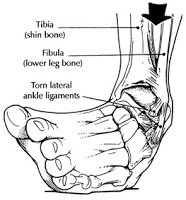The knee is
the largest joint in the body and one that everyone uses daily. It is a hinge joint, which means it is
only capable of flexing, or bending, and extending, yet dancers rely on it for
almost every movement they execute and should, therefore, have a thorough
understanding of it and how it works.
 |
| From Sci-eng.net |
In between
the tibia and the femur are two C-shaped pads of cartilage called the lateral
meniscus and the medial meniscus. Their
job is to provide cushioning between the two bones and to absorb the shock that
comes from the bones hitting against each other while walking, running, and
jumping.
The knee
joint is surrounded by ligaments that provide stability and prevent unwanted
movement that could harm the joint. The
collateral ligaments connect the tibia to the femur on the outside of the knee
(the lateral collateral ligament) and on the inside of the knee (the medial
collateral ligament). These ligaments
prevent sideways movement of the femur.
The anterior collateral ligament, or ACL, crosses the center of the
joint, connects the tibia to the femur, and prevents the tibia from sliding
forward during movement. The posterior
collateral ligament, or PCL, runs directly behind the ACL and prevents the
tibia from sliding backward.
The patella
slides along a groove on the front of the femur and is held in place above by
the quadriceps tendon which connects the thigh muscles to the joint and below
by the patellar tendon which connects the patella to the tibia.
The knee
contains many fluid-filled sacs called bursae that help cushion the joint and
keep the bones moving smoothly against each other.
The four
quadriceps muscles found on the front of the thigh – the rectus femoris, the
vastus intermedius, the vastus lateralis, and the vastus medialis are
responsible for extending the knee.
The
hamstring muscles which are found on the back of the thigh as well as the
gastrocnemius, which is the major calf muscle, and the popliteus, which runs
across the back of the knee, are responsible for bending, or flexing the knee.
Next week’s
post will focus on common knee injuries and concerns that dancers may have and
how to prevent and care for them.



